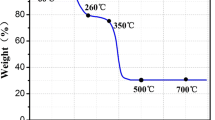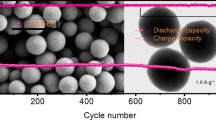Abstract
In the present study, to broaden the application of metal–organic framework (MOF) materials in electronic functional materials, a simple solvothermal method was adopted to introduce bimetals, and metal–organic framework compounds (MIL-101 (Fe), MIL-101 (Fe, Co), MIL-101 (Fe, Cu)) acted as the templates. The hollow structures of Fe2O3, CoFe2O4, and CuFe2O4 were formed through the simple calcinations at 600 °C for 3 h in Ar atmosphere. When the mentioned materials exhibiting hollow structures were tested as the negative electrode of a lithium-ion battery, introducing bimetals was reported to be able to improve their electrochemical performance. For instance, CoFe2O4 and CuFe2O4 were cycled 300 times under a high current density of 1000 mA/g, and the reversible capacity remained to be 978 mAh/g and 774 mAh/g. When 200 cycles were performed under a current density of 200 mA/g, these materials exhibited high specific capacities of 1118 mAh/g and 1155 mAh/g.






Similar content being viewed by others
References
Z.Y. Wang, L. Zhou, X.W. Lou, Metal oxide hollow nanostructures for lithium-ion batteries. Adv. Mater. 24, 1903–1911 (2012)
J. Chen, L. Xu, W. Li, X. Gou, α-Fe2O3 nanotubes in gas sensor and lithium-ion battery applications. Adv. Mater. 17, 582–586 (2005)
N. Sharma, S. Szunerits, R. Boukherroub, R. Ye, S. Ogale, A dual-ligand Fe-MOF based robust high capacity Li ion battery anode and its use in a flexible battery format for electro-thermal heating. Acs Appl. Energy Mater. 2, 4450–4457 (2019)
B.J. Zhu, Z.B. Liang, D.G. Xia, R.Q. Zou, Metal-organic frameworks and their derivatives for metal-air batteries. Energy Storage Mater. 23, 757–771 (2019)
Y. Bai, M. Zeng, X. Wu, Y.Q. Zhang, J. JianWu Wen, Li, Three-dimensional cage-like Si@ZIF-67 core-shell composites for high-performance lithium storage. Appl. Surf. Sci. 510, 145477 (2020)
X. Li, H. Guo, Z. Wang, Z. Yu, Hollow Si/C composite as anode material for high performance lithium-ion battery. Powder Technol. 299, 178–184 (2016)
J.W. Shin, M. Kim, J. Cirera, S. Chen, G.J. Halder, T.A. Yersak, F. Paesani, S.M. Cohen, Y.S. Meng, MIL-101(Fe) as a lithium-ion battery electrode material: a relaxation and intercalation mechanism during lithium insertion. J. Mater. Chem. A 3, 4738–4744 (2015)
P.L. Taberna, S. Mitra, P. Poizot, P. Simon, J.M. Tarascon, High rate capabilities Fe3O4-based Cu nano-architectured electrodes for lithium-ion battery applications. Nat. Mater. 5, 567–573 (2006)
G.T. Qin, L. Ding, M. Zeng, K.B. Zhang, Y.Q. Zhang, Y. Bai, J.W. Wen, J. Li, Mesoporous Fe2O3/N-doped graphene composite as an anode material for lithium ion batteries with greatly enhanced electrochemical performance. J. Electroanal. Chem. 866, 114176 (2020)
Y. Wang, D. Su, A. Ung, J.H. Ahn, G. Wang, Hollow CoFe2O4 nanospheres as a high capacity anode material for lithium ion batteries. Nanotechnology 23, 055402 (2012)
P. Lavela, J.L. Tirado, CoFe2O4 and NiFe2O4 synthesized by sol–gel procedures for their use as anode materials for Li ion batteries. J. Power Sources 172, 379–387 (2007)
L. Wu, Q. Xiao, Z. Li, G. Lei, P. Zhang, L. Wang, CoFe2O4/C composite fibers as anode materials for lithium-ion batteries with stable and high electrochemical performance. Solid State Ion. 215, 24–28 (2012)
Z.H. Li, T.P. Zhao, X.Y. Zhan, D.S. Gao, Q.Z. Xiao, G.T. Lei, High capacity three-dimensional ordered macroporous CoFe2O4 as anode material for lithium ion batteries. Electrochim. Acta 55, 4594–4598 (2010)
R.K. Selvan, N. Kalaiselvi, C.O. Augustin, C.H. Doh, C. Sanjeeviraja, CuFe2O4/SnO2 nanocomposites as anodes for Li-ion batteries. J. Power Sources 157, 522–527 (2006)
G. Qin, X. Wu, J. Wen, J. Li, M. Zeng, A core–shell NiFe2O4@SiO2 structure as a high-performance anode material for lithium-ion batteries. ChemElectroChem 6, 911–916 (2019)
K. Chang, W. Chen, In situ synthesis of MoS2/graphene nanosheet composites with extraordinarily high electrochemical performance for lithium ion batteries. Chem. Commun. 47, 4252–4254 (2011)
G.T. Qin, M. Zeng, X. Wu, J. Wen, J. Li, Fabrication of Fe2O3@TiO2 core–shell nanospheres as anode materials for lithium-ion batteries. J. Mater. Sci.-Mater. El. 29, 12944–12950 (2018)
Lei, He, Yanan, Dong, Yane, Zheng, Qingming, Jia, Shaoyun, A novel magnetic MIL-101(Fe)/TiO2 composite for photo degradation of tetracycline under solar light. J. Hazard. Mater. 361, 85–94 (2019)
Y. Yao, M.T. Mcdowell, I. Ryu, H. Wu, N. Liu, L. Hu, W.D. Nix, Y. Cui, Interconnected silicon hollow nanospheres for lithium-ion battery anodes with long cycle life. Nano Lett. 11, 2949–2954 (2011)
X. Wu, M. Zeng, J.W. Wen, J. Li, Electrochemical studies of MgFe2O4@TiO2 core–shell nanospheres as anode material for lithium battery applications. J. Mater. Sci.-Mater. El. 29, 17872–17880 (2018)
H. Yu, H. Fan, B. Yadian, H. Tan, Q. Yan, General approach for MOF-derived porous spinel AFe2O4 hollow structures and their superior lithium storage properties. Acs Appl. Energy Mater. 7, 26751 (2015)
K.Y. Dong, S.L. Su, G.C. Papaefthymiou, J.Y. Ying, Nanoparticle architectures templated by SiO2/Fe2O3 nanocomposites. Chem. Mater. 18, 614–619 (2006)
H.B. Li, J.Y. Chen, M. Liu, M. Feng, J. Hua, Preparation and characterization of CoFe2O4/SiO2 nanocomposites. Chem. J. Chin. Univ. 28, 614–616 (2007)
H. Chen, Z. He, Z. Huang, L. Song, C. Shen, J. Liu, The effects of multifunctional coating on Li-rich cathode material with hollow spherical structure for Li ion battery. Ceram. Int. 43, 8616–8624 (2017)
J. Wang, G. Yang, L. Wang, W. Yan, W. Wei, C@CoFe2O4 fiber-in-tube mesoporous nanostructure: formation mechanism and high electrochemical performance as an anode for lithium-ion batteries. J. Alloys Compound. 693, 110–117 (2017)
S. Balamurugan, N. Naresh, I. Prakash, N. Satyanarayana, Ion and electron-conducting additive effect on Li-ion charge storage performance of CuFe2O4/SiO2 composite aerogel anode. Cerm. Int. 46, 25330–25340 (2020)
Author information
Authors and Affiliations
Corresponding author
Additional information
Publisher’s Note
Springer Nature remains neutral with regard to jurisdictional claims in published maps and institutional affiliations.
Rights and permissions
About this article
Cite this article
Ding, L., Zeng, M., Wang, H. et al. Synthesis of MIL-101-derived bimetal–organic framework and applications for lithium-ion batteries. J Mater Sci: Mater Electron 32, 1778–1786 (2021). https://doi.org/10.1007/s10854-020-04946-8
Received:
Accepted:
Published:
Issue Date:
DOI: https://doi.org/10.1007/s10854-020-04946-8




